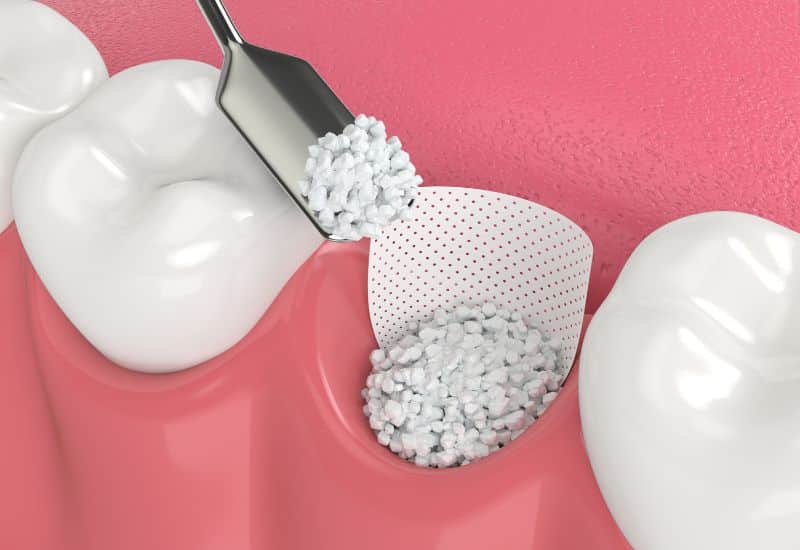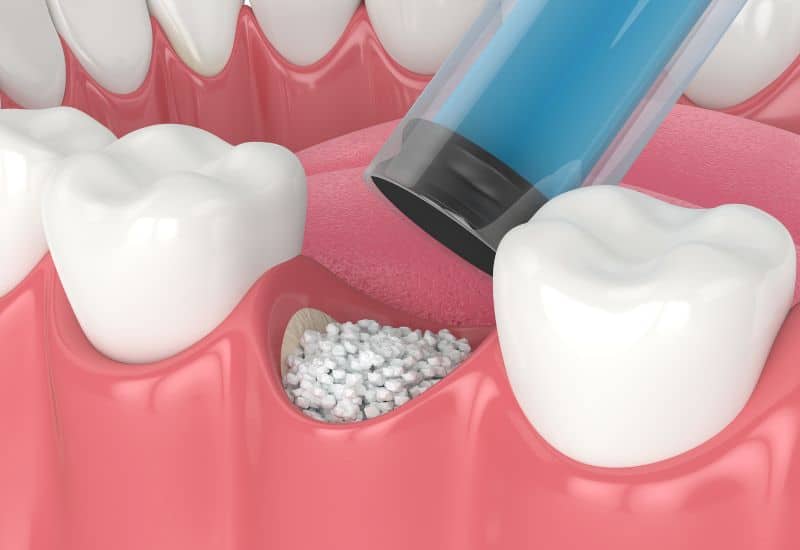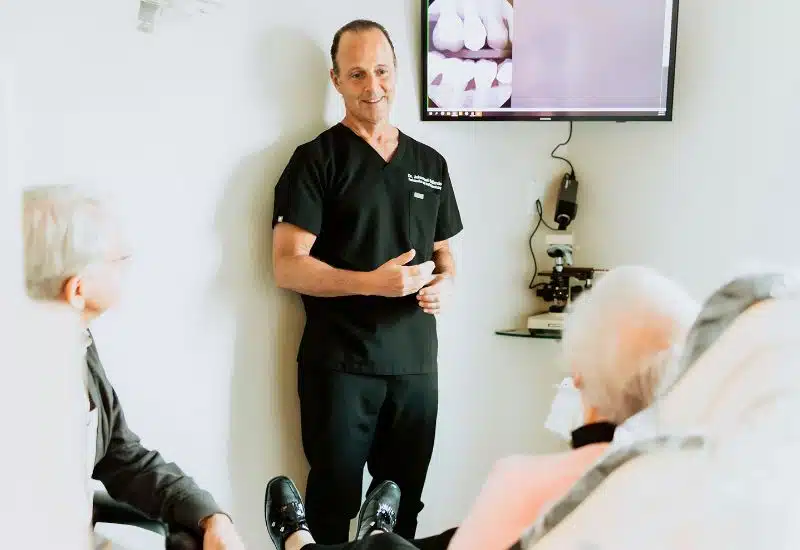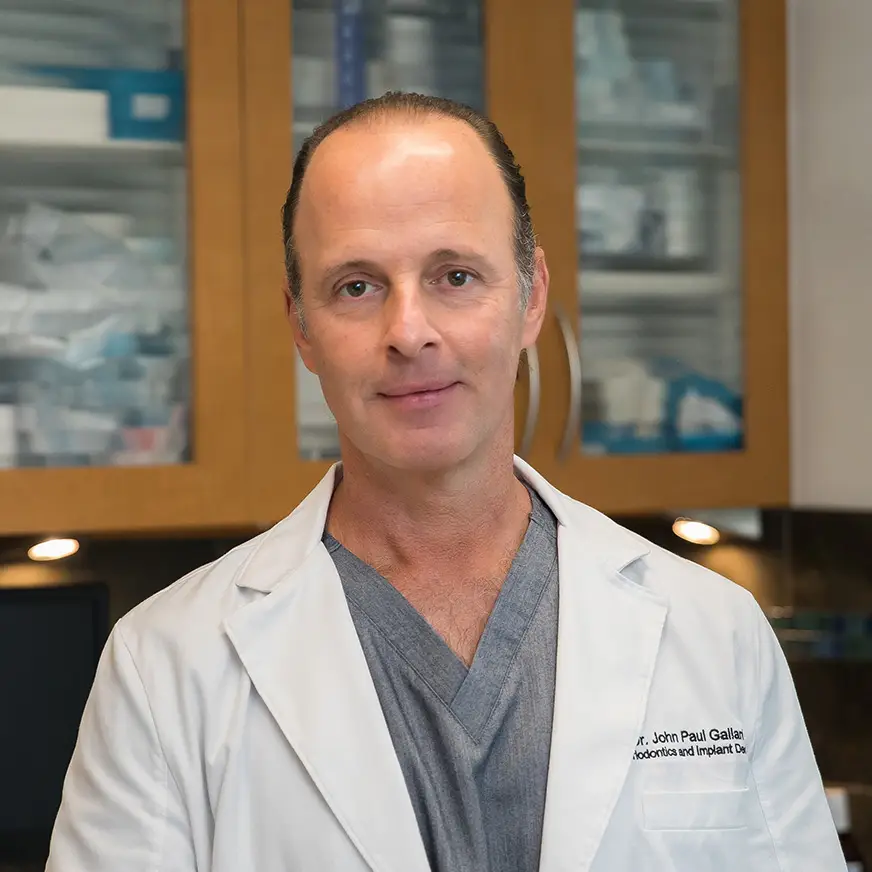Home / Dental Services / Bone Grafting
Bone Graft for Dental Implants in Miami
Many patients seeking dental implants face the challenge of insufficient bone. Dr. John Paul Gallardo, a top periodontist in Miami, offers advanced bone grafting procedures to rebuild the jawbone, ensuring a stable foundation for dental implants. With over 30 years of experience, Dr. Gallardo provides expert care to promote new bone growth and ensure implant success.
Why Bone Grafting is Key for Dental Implants
- Bone grafting improves dental implant success by providing a stable foundation, reducing implant failure, and ensuring long-term durability.
- It restores facial contours, preventing the sunken appearance from bone loss, enhancing appearance, and boosting confidence.
- Strengthening the bone structure with a graft protects neighboring teeth and gums, prevents further bone loss, and supports oral health.
- Procedures like sinus lifts, ridge expansions, and nerve repositioning address different bone loss issues for a personalized approach.
- Rebuilding the jaw with grafting prevents tooth loss by maintaining a healthy bone foundation, supporting teeth, and improving bite function.
What is Dental Bone Grafting?
Dental bone grafting is a surgical procedure designed to augment the bone tissue in your jaw. This procedure is typically necessary when there is insufficient bone volume to support dental implants. By adding bone graft material, dental bone grafting promotes the growth of new bone tissue, providing a sturdy base for dental implants.
Bone loss should not be left untreated, as it can compromise the success of future dental work. Dr. John Paul Gallardo offers advanced dental bone grafting in Miami, Florida, to restore lost bone and ensure your oral health is prepared for long-term success.

Types of Bone Grafting
Major Bone Grafting
Major bone grafting is typically required when there is significant bone loss due to periodontal disease, trauma, or long-term tooth loss. This procedure often involves transplanting bone from another part of the patient's body or using donor bone from a human or animal tissue bank.
Minor Bone Grafting
Minor bone grafting is usually performed at the time of tooth extraction to preserve the bony ridge necessary for implant placement. This procedure involves filling the socket with bone graft material immediately after the tooth is removed.
Why You Might Need Bone Grafting
Bone Grafting Techniques
for Dental Implants
01
Sinus Lift
A sinus lift is a procedure that adds bone to your upper jaw in the area of your molars and premolars. This procedure is often necessary when the sinus floor is too close to the upper jaw for implants to be placed.
02
Ridge Expansion
03
Nerve-Repositioning
What Material Is Used for Dental Bone Grafting?
The preferred material for dental bone grafting is autogenous bone, or bone harvested from the patient’s own body. This live bone contains cellular elements that enhance bone growth.
However, in cases where a second procedure to harvest bone is not advisable, alternative sources such as allogenic bone (from a cadaver) or xenogenic bone (from another species, mostly cows) can be used. These serve as a framework for the surrounding bone to grow over.
Synthetic options, such as demineralized bone matrix, are also available.

The Bone Grafting Procedure
Dr. Gallardo’s bone grafting procedures are meticulously carried out to ensure patient comfort and successful outcomes. Here’s what you can expect:
Step 1
Initial Preparation
Dr. Gallardo will administer local anesthesia or IV sedation to ensure your comfort throughout the bone grafting procedure.
Step 2
Incision and Bone Exposure
A small incision is made in the gum tissue to expose the area suffering from bone loss.
Step 3
Harvesting Bone (if Autograft)
For an autograft, bone is harvested from another part of your body, such as the chin, jaw, hip, skull, or lower leg.
Step 4
Placement of Bone Graft Material
The bone graft material, either from your own body or a donor, is carefully placed into the area needing regeneration.
Step 5
Membrane Application (if Necessary)
Step 6
Suturing and Healing
The gum tissue is sutured closed to protect the graft, aiding in the healing process.
What Our Patients Say
Committed to your results

Recovery from Bone Grafting for Dental Implants
Post-bone grafting, it’s vital to give your body the time it needs to heal properly.
You should relax during the first day, with plans to slowly increase activity levels back to your usual routine. Dr. Gallardo suggests keeping physical activity low for the initial week.
He will prescribe any necessary pain medication to ease discomfort and swelling. These are common for a few days post-op.
Stick to good oral hygiene practices and adhere closely to Dr. Gallardo’s aftercare advice, including no smoking, gentle brushing, and antibacterial mouthwash rinses.
The healing timeline varies, with new bone growth potentially taking months. Once you’ve healed fully, Dr. Gallardo will move forward with the dental implant placement to rejuvenate your smile and oral health.

Why Choose Dr. Gallardo for Your Bone Grafting Procedure
Dr. John Paul Gallardo is a highly experienced periodontist and dental implant expert with 30 years of experience in the field. Choosing Dr. Gallardo for your dental implant bone grafting procedure offers several advantages:
- Meticulous attention to detail and unique techniques that yield long-lasting results
- State-of-the-art facility offering safe and effective treatments with minimal downtime
- One of the few providers of IV conscious sedation in South Florida
- Active involvement in various organizations, including the University of Florida, Florida Association of Periodontists, and North American Society of Periodontists
- Featured in media outlets like the Miami Herald and Univision as an expert contributor to oral health-related news
- He instructs dental students at the University of Florida and hosts a study group for doctors to share knowledge on implant dentistry advances.
By choosing Dr. Gallardo for your dental implant bone grafting, you can have confidence in his expertise and commitment to providing the highest level of care for your oral health needs.
Frequently Asked Questions About Dental Bone Grafting
Do dental bone grafts hurt?
During the grafting procedure, Dr. Gallardo will administer local anesthesia or IV sedation to ensure your comfort, minimizing any pain or discomfort. After the surgery, you may experience some moderate pain and swelling, which can be managed with the prescribed medication.
Does bone grafting prevent dry socket?
While jawbone grafting is not specifically designed to prevent dry socket, it does help preserve the socket after tooth extraction. This can reduce the risk of potential complications. By filling the socket with bone graft material, the procedure supports proper healing and promotes new bone growth.
Does a bone graft prevent teeth from shifting?
Bone grafting can help maintain the health and stability of neighboring teeth by replacing lost bone in the jaw. This, in turn, provides support to the surrounding teeth and prevents them from shifting due to bone loss or tooth extraction.
Will you use my own bone for the graft?
Dr. Gallardo prefers to use autogenous bone grafts, or autografts, which are harvested from the patient’s own body. This is because autografts contain living cellular elements that enhance bone growth. However, in cases where a second procedure to harvest bone is not advisable, alternative sources such as allogenic bone (from a cadaver) or xenogenic bone (from another species) can be used.
Are there any alternatives to real bone?
Yes, there are several synthetic options available for bone grafting, such as demineralized bone matrix (DBM). These materials offer an alternative to real bone while still promoting new bone formation and healing.
Where do you do bone grafting procedures?
Dr. Gallardo performs most bone grafting procedures at his out-of-office surgical suite in Miami, FL, using IV sedation or general anesthesia to ensure patient comfort and safety.
Will I have to stay in the hospital?
Patients typically do not need to stay in the hospital after a bone grafting procedure. However, a caretaker is required for the first day or so due to the sedation used during the surgery.
What is the recovery like?
Following a bone grafting procedure, you can expect to rest in bed for the first day, with a gradual return to normal activities over the following days. It is recommended to limit physical activity for the first week after the procedure. Dr. Gallardo will prescribe medication to manage any pain, and you may experience moderate swelling and discomfort for a few days.